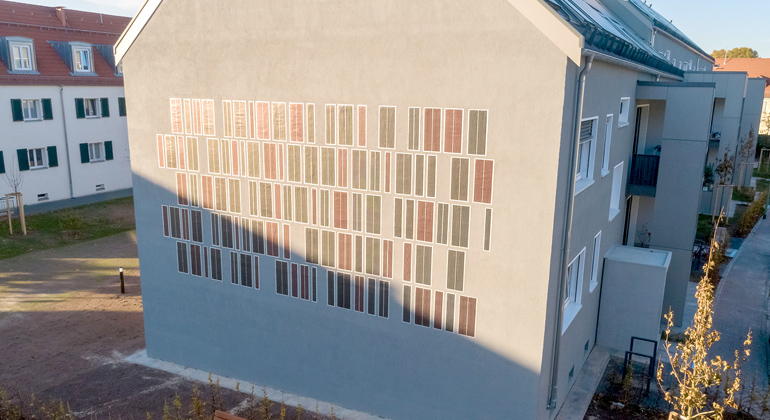The first thermal insulation composite system with integrated photovoltaics
The integration of renewable energies in the building sector generally represents an enormous challenge.
The future of the building envelope is the focus of the four-year-old cooperation between DAW SE and the OPVIUS GmbH company. An ambitious sustainability strategy has been a major feature of this cooperation from the very beginning. The result of the cooperation is revealed in the recently completed project in Frankfurt: a multifunctional façade system was installed in the plaster layer of the building. This OPV system supplements the functionality of the thermal insulation composite system (TICS) as an “active component”.
The concept behind it is that in the future, it will not only be possible to include the energetic recordings of the building envelope in energy balancing from passive components, such as thermal insulation, but also that a combination of active energy generation and passive thermal insulation will lead to a total balancing.
The integration of renewable energies in the building sector – particularly in renovation projects – generally represents an enormous challenge. Hitherto, the integration of photovoltaic has almost exclusively been possible in new construction projects, as the format of photovoltaic modules available is not compatible with building geometries. Moreover, the design flexibility of the modules is severely limited. The construction of façades with classical, glass-based modules generally requires curtain walls, which are complicated and expensive to build.
In Frankfurt, DAW and OPVIUS have now been able to show that thanks to the OPVIUS OPV technology, it is possible to integrate printed OPV solar modules into a conventional façade product. This results in a thermally insulated façade with a classical TICS and an OPV-based, flexible plaster tile incorporated into the surface of the plaster. The façade not only includes an energetically valuable component but also experiences an aesthetic upgrading as a result of the OPV inlays. The system developed is transferable to all building types and façades constructed with TICS today, and thus represents an actual solution to the problem of PV façades in existing housing stock.
“The German Energy Saving Ordinance allows us to include yields from building-integrated photovoltaics in the primary energy balance of buildings, thereby counteracting the strong increases in the insulation thicknesses”, explains Dr. Thomas Loewenstein, Project Leader at DAW SE: “This is therefore an outstanding result for the future, whereby the enrichment of passive thermal insulation by an active component provides a financial upgrading of façades.”
“The design freedom afforded by OPV in combination with a favourable, conventional building product opens up entirely new markets. In respect of the energy transition and the forthcoming energetic renovation of a huge number of existing buildings, this represents a new as well as simple solution for the future” according to Hermann Issa, Senior Director Business Development & Sales at OPVIUS GmbH.









